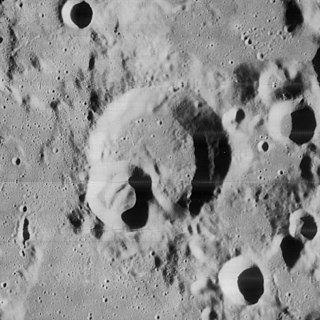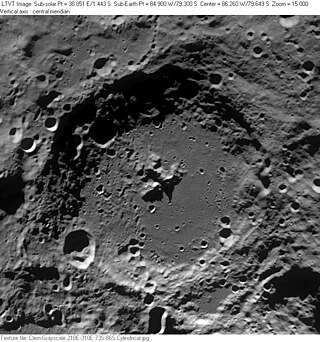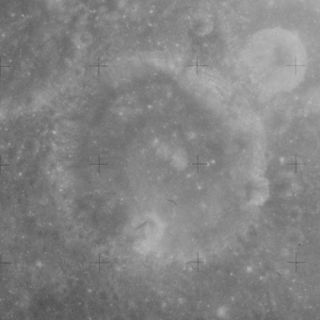
Artamonov is a lunar impact crater on the far side of the Moon. Its eroded outer rim does not have the circular shape of most lunar craters, but the overall shape of three or four merged craters. The largest is in the south, with smaller circular bulges to the north and east.

Beals is a lunar impact crater that is located near the eastern limb of the Moon, and lies across the southwestern rim of the crater Riemann. From the Earth the crater is viewed nearly from on edge, and is best seen during favorable librations. To the west is the large walled plain Gauss.

Pontécoulant is a prominent lunar impact crater that is located in the southeastern part of the Moon. Due to its position, the crater appears foreshortened from the Earth and it is difficult to observe much detail. Nearby craters include Hanno just to the northeast, and the comparably sized Helmholtz due south.

Lacroix is a crater that is located in the southwest part of the Moon, to the northwest of the large walled plain Schickard. The most notable feature of this crater is the smaller crater Lacroix J that overlies the southern rim. The surviving rim of Lacroix is nearly circular, with a slightly worn inner wall. The interior floor is relatively featureless.

Brisbane is a lunar impact crater that is located in the southeastern part of the Moon, to the south of the crater Peirescius. To the northwest lie the craters Vega and Reimarus, and farther to the east is the walled plain Lyot. Due to its proximity to the limb, foreshortening of this crater causes it to appear somewhat elliptical in shape, even though it is actually circular.

Cusanus is a lunar impact crater that is located near the northeastern limb of the Moon. In this location the crater appears very foreshortened when observed from the Earth, and its visibility is affected by libration. The northern rim of Cusanus is nearly joined to the south-southeastern rim of the larger crater Petermann. To the west is Baillaud and to the southeast is Hayn.

Casatus is a lunar impact crater that is located near the southern limb of the Moon. The north-northeast rim of the crater overlies a portion of the slightly larger crater Klaproth. Along the western rim, Casatus A intrudes somewhat into the interior, producing an inward-bowing rim. To the southeast of Casatus is Newton.

Drygalski is a large lunar impact crater that lies along the southern limb of the Moon. It partly overlies the crater Ashbrook to the west on the far side of the Moon. Just to the north of Drygalski is the smaller Boltzmann. The location of this crater restricts its observation from the Earth, and even under conditions of favorable libration it is viewed from the edge. It is only illuminated by the Sun at an oblique angle, and it lies close to the south polar craters that are permanently shielded from sunlight.

Cori is a lunar impact crater that is located in the southern hemisphere on the far side of the Moon. It lies less than one crater diameter to the north of the crater Baldet. To the northeast is the crater Grissom. It is named after Gerty Cori, the first American woman to win the Nobel Prize and the first woman to win the prize in the category Nobel Prize in Physiology or Medicine.

Carver is a lunar impact crater that is located on the far side of the Moon, due east of the walled plain Van der Waals. To the northeast is the crater Rosseland, and to the south-southeast lies Kozyrev.

Carnot is a large crater in the northern part of the Moon's far side. It was named after Nicolas L. S. Carnot by the IAU in 1970.

Dyson is a lunar impact crater, 63 kilometers in diameter, that lies on the far side of the Moon, past the northwest limb. It is located in the northern part of the surface, to the northwest of the crater Coulomb, and east of van't Hoff.

Chauvenet is a lunar impact crater that is located to the northeast of the prominent crater Tsiolkovskiy on the far side of the Moon. Less than one crater diameter to the northwest of Chauvenet is the crater Ten Bruggencate.

Van Vleck is a lunar impact crater that is located near the northeastern rim of the walled plain Gilbert, to the west of the Mare Smythii. The similar crater Weierstrass is nearly joined to the northwestern rim of Van Vleck. To the east is the small Carrillo.

Chappe is a lunar impact crater that lies along the southwestern limb of the Moon. It is nearly attached to the northern limb of the walled plain Hausen, and an equal distance from the crater Pilâtre. To the north-northwest is Blanchard.

Delporte is a lunar impact crater on the far side of the Moon. It overlies part of the northwestern rim of the huge walled plain Fermi, and the crater Litke is nearly attached to the southeastern rim. The crater is named after Eugène Joseph Delporte.

Edison is a lunar impact crater on the far side of the Moon. It is located just behind the north-northeastern limb of the Moon, a region that is sometimes brought into sight from Earth during favorable librations. However even at such times not much detail can be discerned, and the crater is better observed by orbiting spacecraft.

Langemak is a prominent impact crater on the far side of the Moon. It is located less than one crater diameter west-northwest of Danjon, and nearly due east of Meitner. To the southwest of Langemak is Kondratyuk. Langemak partly overlies the larger and older crater Langemak N. This feature is also attached to the northeastern rim of Kondratyuk.

Maxwell is a crater on the far side of the Moon named after the physicist James C. Maxwell. It lies in the southwestern part of the larger crater Richardson. The southern part of Maxwell is overlain in turn by the partly flooded Lomonosov. Less than one crater diameter to the southwest is the larger Joliot.

Obruchev is a disintegrating lunar impact crater that lies along the southern shore of Mare Ingenii, on the far side of the Moon. Less than three crater diameters to the south of Obruchev is the crater Chrétien, and about the same distance to the southeast lies Oresme.






















